Container Designs Without Annuals
Save time and money with container designs that don’t make you start from scratch every spring
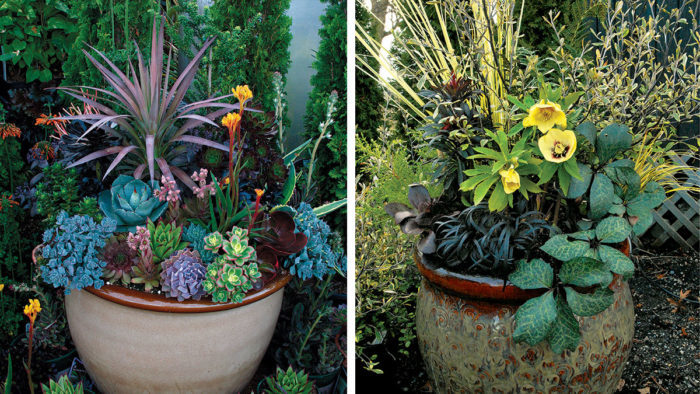
The world of perennials has never been so diverse or so useful. New varieties offer more colorful foliage, longer bloom times, and dwarf habits that are perfect for small spaces and containers. Drawing inspiration from the huge plant selection at our nursery, we’ve opted to shove annuals right out of the pot picture. Our designs feature perennials, shrubs, and a few succulents to create sophisticated, colorful, and intriguing containers. In addition to their beauty, perennials are more sustainable and cost-effective than annuals because they live for years; if a plant outgrows its container or starts to outcompete its neighbors (or if you just want to change the design), simply move it into the garden. Perennials also look great early in the season because annuals usually need more time and some warm weather to fill out.
Foliage always comes first in perennial container design. The shape, size, texture, and color of the foliage (and the repetition of these characteristics) are what make a stunning and dynamic container—even without flowers. Our pots are planted densely. We like to think of them as a cross between a conventional container and a bouquet. Planted so tightly, the design will look great for a couple of seasons with some limited maintenance. If planted less densely, these perennial containers could last for years with only minor tweaks.
Jewel tones add depth to a nearly flower-free design
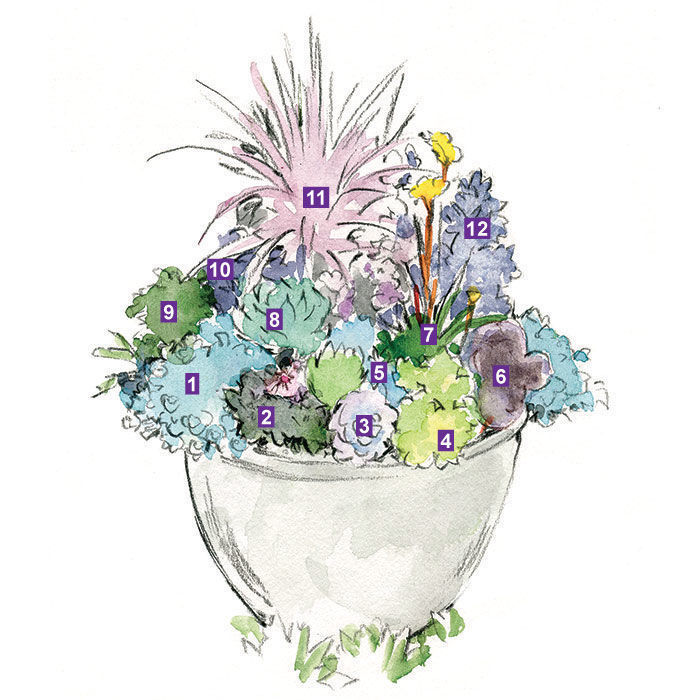
The plants in this treasure trove of succulents were chosen for their contrasting color, size, texture, and shape. The focal point of the design is the architectural starburst of burgundy foliage from the yucca. To add some comparable interest around the edges of the pot, we planted shades of blue, pink, burgundy, electric green, and yellow. The array of these succulents proves that you don’t need blossoms to create a colorful impact, and the play of different textures gives the design a sculptural quality. This jewel box will dazzle and sparkle all season long in warm zones or inside in chillier areas.
- ‘Lidakense’ sedum (Sedum cauticola ‘Lidakense’, Zones 5–9)
- ‘Chocolate’ and ‘Prairie Sunset’ hen and chicks (Sempervivum ‘Chocolate’ and ‘Prairie Sunset’, Zones 4–9)
- ‘Pink Frills’ echeveria (Echeveria shaviana ‘Pink Frills’, Zones 9–11)
- ‘Tricolor’ aeonium (Aeonium ‘Tricolor’, Zones 9–11)
- Pachyphytum (Pachyphytum compactum, Zone 11)
- Purple echeveria (Echeveria atropurpurea, Zones 10–11)
- ‘Bush Nugget’ kangaroo paw (Anigozanthos ‘Bush Nugget’, Zones 10–11)
- Parry’s agave (Agave parryi var. huachucensis, Zones 9–11)
- ‘Jet Beads’ sedum (× Sedeveria ‘Jet Beads’, Zones 8–11)
- ‘Zwartkop’ aeonium (Aeonium arboreum ‘Zwartkop’, Zones 9–11)
- ‘Blue Boy’ yucca (Yucca desmetiana ‘Blue Boy’, Zones 8–10)
- Aeonium (Aeonium cv., Zones 9–11)
White sparkles during the day but dazzles at night

If you’ve always been intrigued by moon gardens but never wanted to commit to creating one, here is our answer. This pot is a study in black and white designed to intrigue during the day and to shimmer at night. The pale hues pop against the dark-side-of-the-moon blacks and burgundies. This play of light and dark fills the foreground with contrast. The design builds interest upward with strong verticality from the variegated veronica, rattlesnake master, canna, and the nonstop blooms of the show-stopping giant fleeceflower.
- ‘Whitewater’ veronica (Veronica ‘Whitewater’, Zones 4–7)
- ‘Lidakense’ sedum (Sedum cauticola ‘Lidakense’, Zones 5–9)
- ‘Black Scallop’ ajuga (Ajuga reptans* ‘Black Scallop’, Zones 3–9)
- Moroccan daisy (Rhodanthemum hosmariense, Zones 9–11)
- ‘Silver Swan’ euphorbia (Euphorbia characias ‘Silver Swan’, Zones 7–10)
- Graptopetalum (Graptopetalum pentandrum subsp. superbum, Zones 9–11)
- Blackbird™ euphorbia (Euphorbia ‘Nothowlee’, Zones 6–9)
- ‘Glitter’ heuchera (Heuchera ‘Glitter’, Zones 4–9)
- ‘Picolette’ sedum (Sedum ‘Picolette’, Zones 3–9)
- ‘Zwartkop’ aeonium (Aeonium arboreum ‘Zwartkop’, Zones 9–11)
- ‘Charlotte’ veronica (Veronica longifolia ‘Charlotte’, Zones 4–8)
- Giant fleeceflower (Persicaria polymorpha, Zones 4–9)
- Bird of Paradise™ canna (Canna ‘BWPar’, Zones 8–11)
- Rattlesnake-master (Eryngium yuccifolium, Zones 4–9)
Tip: Start with the focal points
When planting, start by placing the largest plants (the architectural features) in the container, then work your way out to the sides of the pot using smaller plants. If you’re planting densely, don’t be afraid to root-prune the plants. They won’t mind a small reduction in their root volume as long as you keep the pot well watered after planting.
Searing hues always stand out
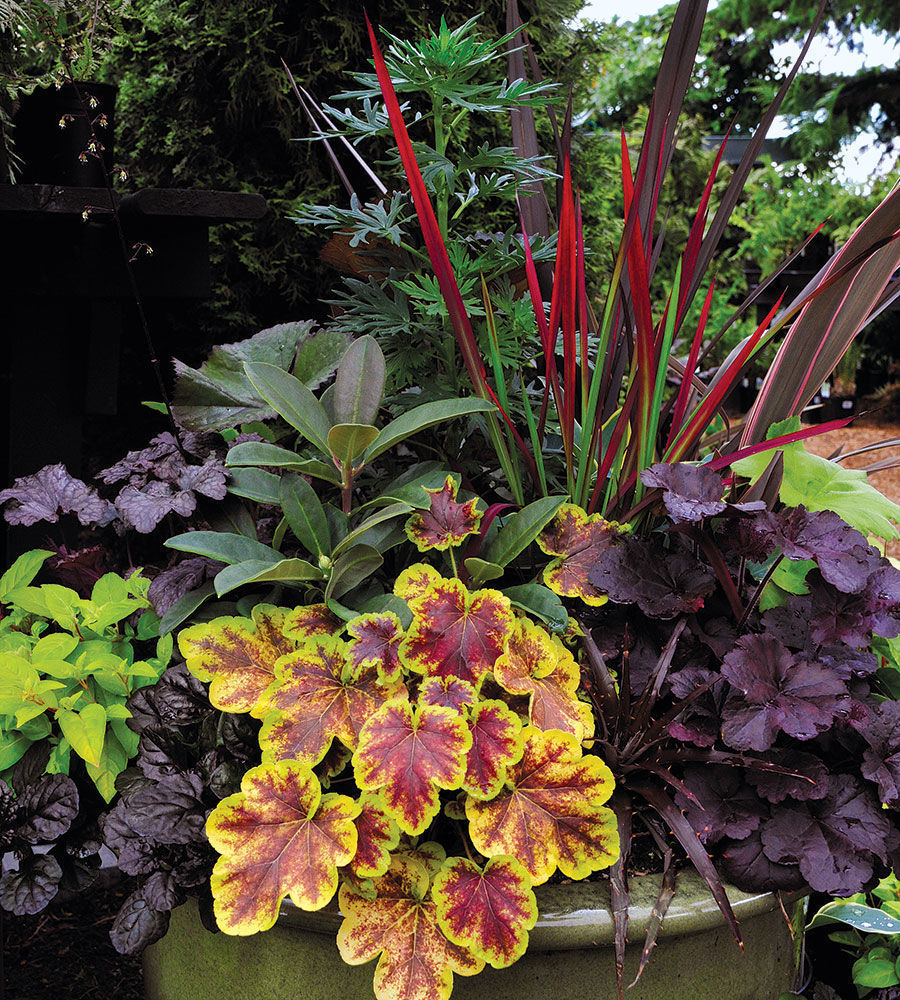
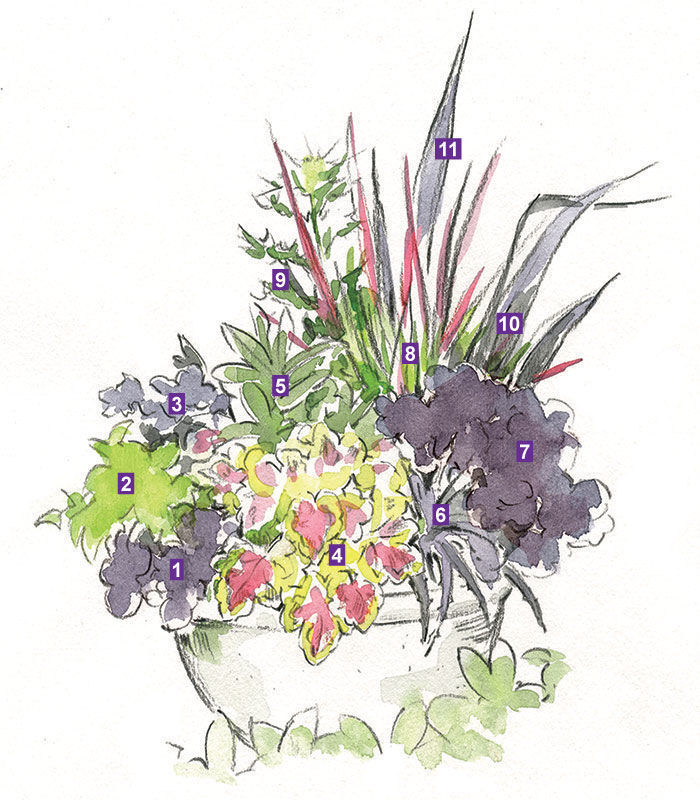
The star of this container is ‘Solar Eclipse’ heucherella. The sharp contrasts between the golds and burgundies are mediated by the bright greens of ‘Golden Gate’ fuchsia and the deep green of the rhododendron. To give the top of the design as much interest as the base, we added the monkshood and the sharp, sword-shaped leaves of New Zealand flax to draw the eye upward. Japanese blood grass is the other star of the arrangement, with its vivid green and bright red shoots echoing the hues of ‘Solar Eclipse’.
- ‘Black Scallop’ ajuga (Ajuga reptans ‘Black Scallop’, Zones 3–9)
- ‘Golden Gate’ fuchsia (Fuchsia ‘Golden Gate’, Zones 7–11)
- ‘Plum Pudding’ heuchera (Heuchera ‘Plum Pudding’, Zones 4–9)
- ‘Solar Eclipse’ heucherella (× Heucherella ‘Solar Eclipse’, Zones 4–9)
- ‘Emma and May’ rhododendron (Rhododendron fortunei ‘Emma and May’, Zones 6–9)
- ‘Burgundy Ice’ dyckia (Dyckia ‘Burgundy Ice’, Zones 7–11)
- ‘Creole Nights’ heuchera (Heuchera ‘Creole Nights’, Zones 4–9)
- Japanese blood grass (Imperata cylindrica ‘Rubra’, Zones 5–9)
- ‘Blue Lagoon’ monkshood (Aconitum ‘Blue Lagoon’, Zones 4–8)
- ‘Pink Stripe’ New Zealand flax (Phormium ‘Pink Stripe’, Zones 8–11)
- ‘Red Sparklers’ New Zealand flax (Phormium ‘Red Sparklers’, Zones 8–11)
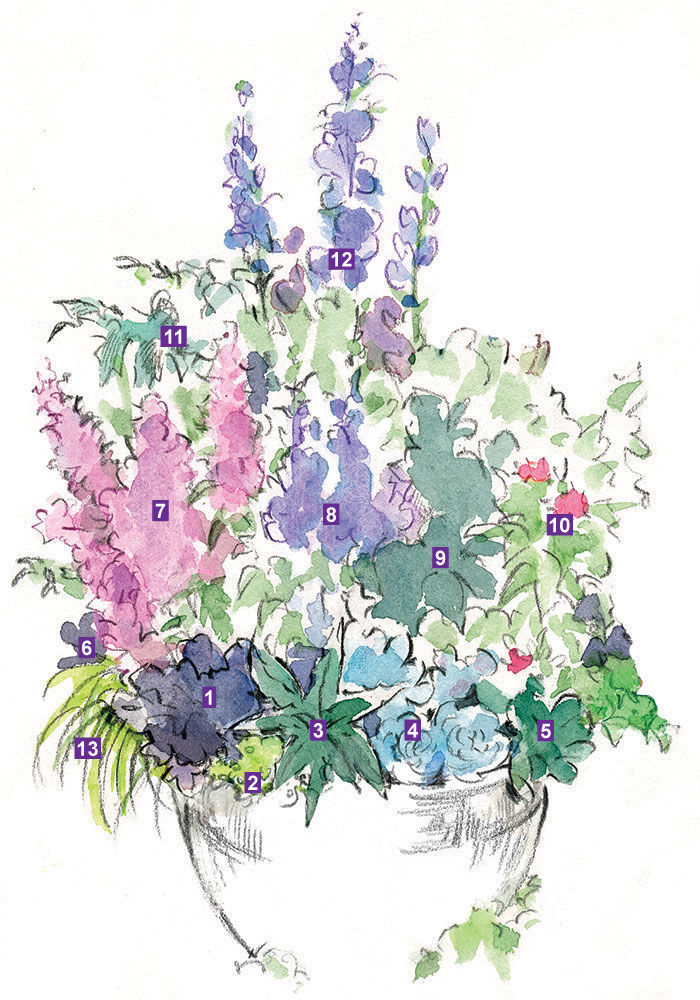
In this grouping, electric blues and hot pinks flirt with each other like boys and girls at the beach. The background of dark foliage sets the scene for the nonstop blooms of agastache, bee balm, and penstemon and for the new bright pink foliage of ‘Rose Glow’ Japanese barberry. ‘Newry Blue’ monkshood adds a shot of color and interest at the top of the design, while the golden foliage of ‘Everillo’ sedge and ‘Sunshine’ veronica and the succulent rosettes of ‘Pink Frills’ echeveria provide a color boost at the base of the pot. ‘Jaws’ agave creates a left-of-center structural kick that balances out the flowery frills.
- ‘Coco’ heuchera (Heuchera ‘Coco’, Zones 4–9)
- ‘Sunshine’ veronica (Veronica repens ‘Sunshine’, Zones 6–9)
- ‘Jaws’ agave (Agave gentryi ‘Jaws’, Zones 7–11)
- ‘Pink Frills’ echeveria (Echeveria shaviana ‘Pink Frills’, Zones 9–11)
- ‘Sunset Strain’ lewisia (Lewisia cotyledon ‘Sunset Strain’, Zones 4–9)
- ‘Rose Glow’ Japanese barberry (Berberis thunbergii ‘Rose Glow’, Zones 5–8)
- Grape Nectar™ agastache (Agastache ‘Grape Nectar’, Zones 7–10)
- ‘Margarita BOP’ penstemon (Penstemon heterophyllus ‘Margarita BOP’, Zones 6–10)
- ‘Happy Single Kiss’ dahlia (Dahlia ‘Happy Single Kiss’, Zones 9–11)
- ‘Pardon My Pink’ bee balm (Monarda didyma ‘Pardon My Pink’, Zones 4–9)
- ‘Brunette’ bugbane (Actaea simplex ‘Brunette’, Zones 4–8)
- ‘Newry Blue’ monkshood (Aconitum napellus ‘Newry Blue’, Zones 3–8)
- ‘Everillo’ sedge (Carex oshimensis ‘Everillo’, Zones 5–9)
Pair black and yellow in early spring

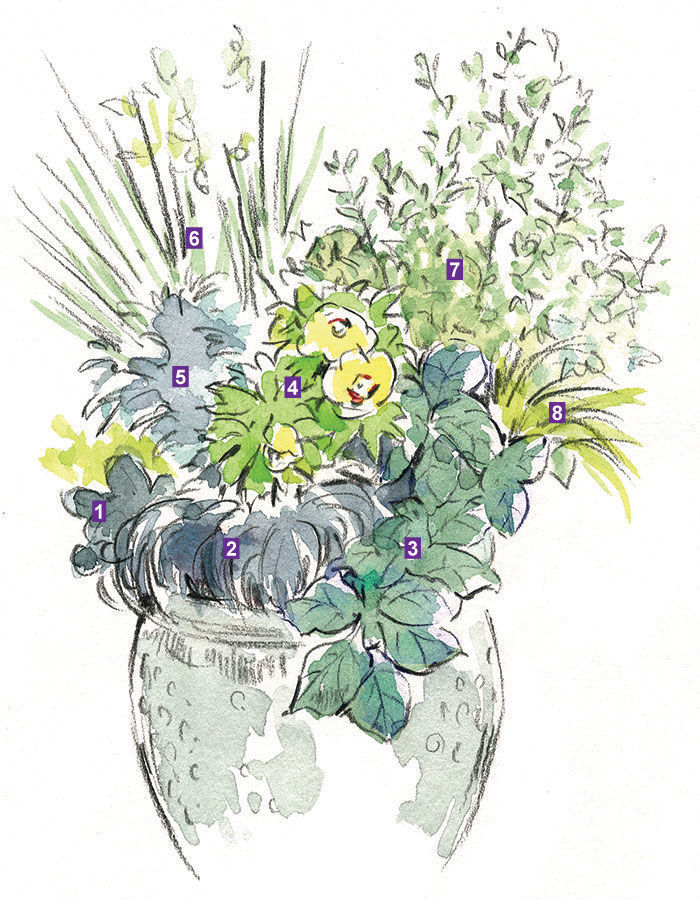
The butter yellow blooms of ‘Golden Sunrise’ hellebore and the silver-veined, blue-green foliage of ‘Winter Moonbeam’ hellebore perfectly capture and reflect back the soft light of spring. At play around the hellebores are contrasts of light and dark with the foliage of the black mondo grass, euphorbia, and bergenia creating a rich, brooding presence. These black and plum tones contrast with the bright foliage of the variegated pampas grass (and its little sibling, the golden dwarf sweet flag) and the delicate, airy branches of the corokia, which flare outward from the pot like rays of spring sunshine.
- ‘Lunar Glow’ bergenia (Bergenia ‘Lunar Glow’, Zones 4–9)
- Black mondo grass (Ophiopogon planiscapus ‘Nigrescens’, Zones 6–11)
- ‘Winter Moonbeam’ hellebore (Helleborus × ericsmithii ‘Winter Moonbeam’, Zones 5–8)
- ‘Golden Sunrise’ hellebore (Helleborus ‘Golden Sunrise’, Zones 4–9)
- Blackbird™ euphorbia (Euphorbia ‘Nothowlee’, Zones 6–9)
- ‘Gold Band’ pampas grass (Cortaderia selloana* ‘Gold Band’, Zones 7–10)
- ‘Sunsplash’ corokia (Corokia × virgata ‘Sunsplash’, Zones 8–10)
- Golden dwarf sweet flag (Acorus gramineus ‘Ogon’, Zones 6–9)
Perennial containers require special care
Although they are generally lower maintenance compared with pots filled with annuals, perennial containers do have some specific care requirements. To help your pots go the distance over multiple seasons, keep the following considerations in mind.

In spring
- Pay attention to zones when selecting plants, remembering that perennials and shrubs in containers are not insulated by the ground and usually lose one zone of hardiness due to the stress of winter freeze/thaw cycles. Choose plants that are one to two zones hardier than your zone.
- Line the inside walls of the pot if you live in a cold region. Before you fill your container with potting mix, insulate the inside walls with bubble wrap (for curved containers) or a Styrofoam insulation board (for square or rectangular containers); trim the insulation to approximately 2 to 3 inches below the container lip. This helps protect the roots from freezing in winter and getting too scorched in summer.
- Be sure to edit after a full year or two. In spring, remove plants that have grown too big. Retire them to the garden, or divide them (we like to use a serrated chef’s knife) and replant a smaller division. You can also play with your design by replacing some plants with newfound treasures.
- Remove the top layer of soil (2 to 3 inches) in subsequent springs, and replace it with a good-quality compost and slow-release fertilizer.

In fall
- Remove tender plants every fall, and overwinter them indoors. You can replace them with hardy, seasonal varieties for winter interest, if you wish. You might also use twigs, boughs, seedpods, and various cones to fill the winter gaps until you replant your tender treasures in spring.
- Insulate the top of the pot by collecting fallen leaves and packing them on top of or around your plants.
- Move small containers to a protected location. Many containerized plants will do better in a sheltered spot, such as against the house, where they are less exposed to rain, snow, frost, and wind.
- Keep containers watered even in winter, unless the soil is frozen solid.
Gary Lewis is the Canada Region director of the Perennial Plant Association and owner of Phoenix Perennials and Specialty Plants in Richmond, British Columbia. Shelley Brignall is the lead container designer at Phoenix Perennials and Specialty Plants.
Photos, except where noted: Danielle Sherry
From Fine Gardening #158
Fine Gardening Recommended Products

Gardener's Log Book from NYBG
Fine Gardening receives a commission for items purchased through links on this site, including Amazon Associates and other affiliate advertising programs.

Planting in a Post-Wild World: Designing Plant Communities for Resilient Landscapes
Fine Gardening receives a commission for items purchased through links on this site, including Amazon Associates and other affiliate advertising programs.








Comments
Log in or create an account to post a comment.
Sign up Log in